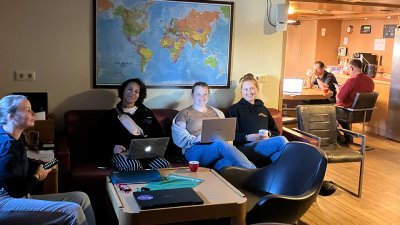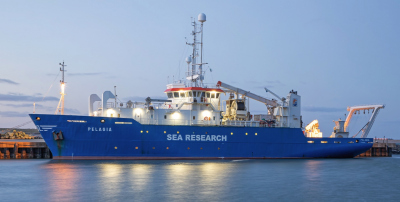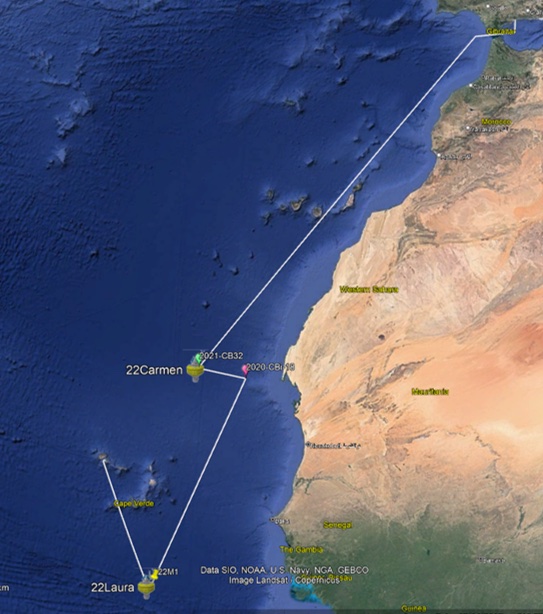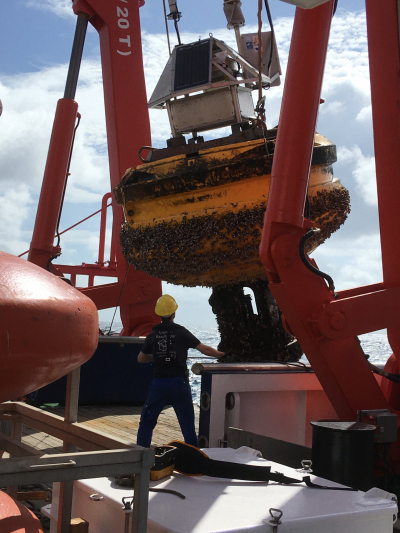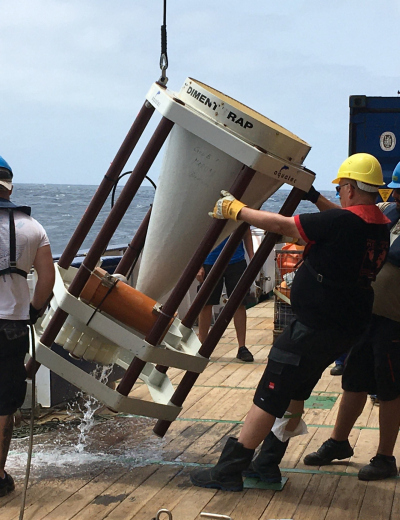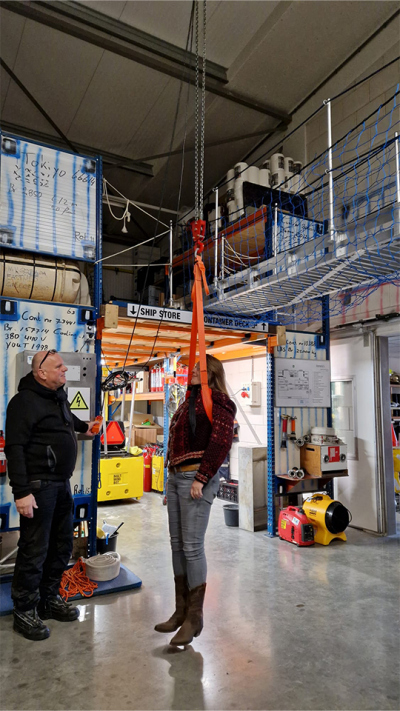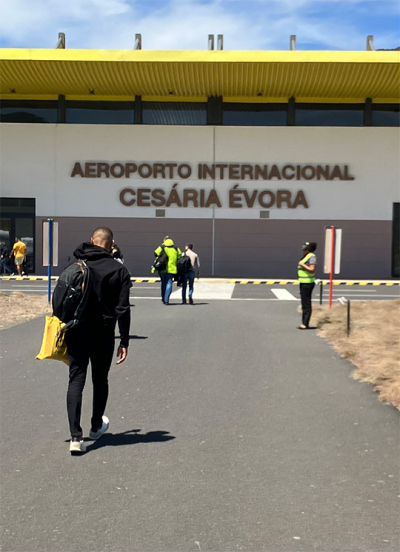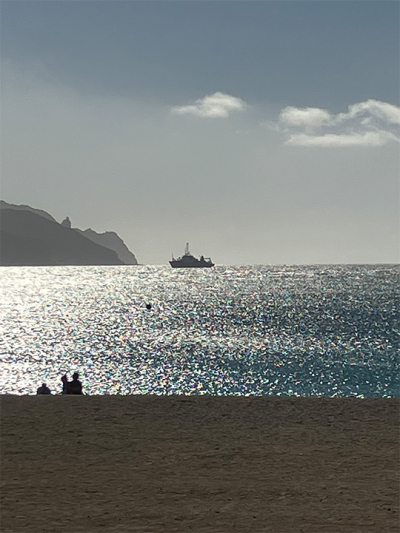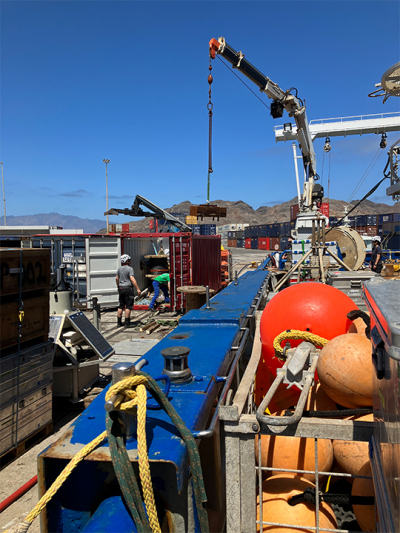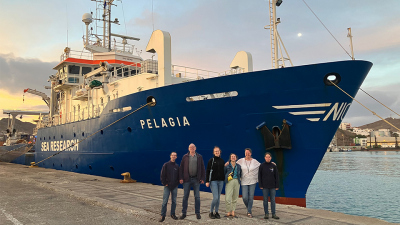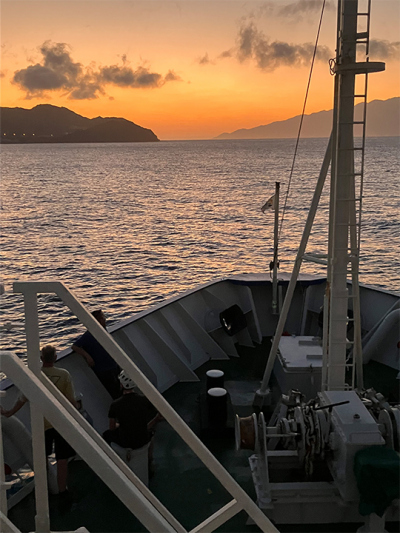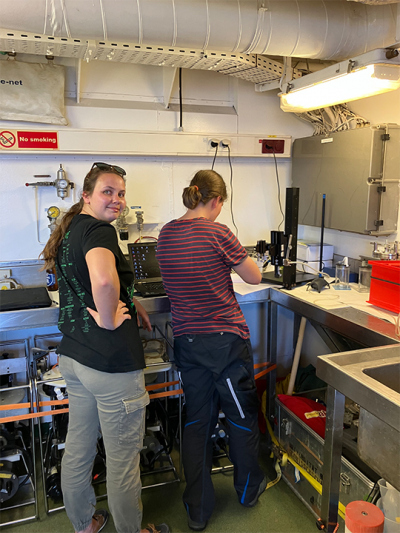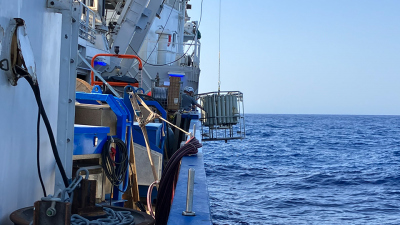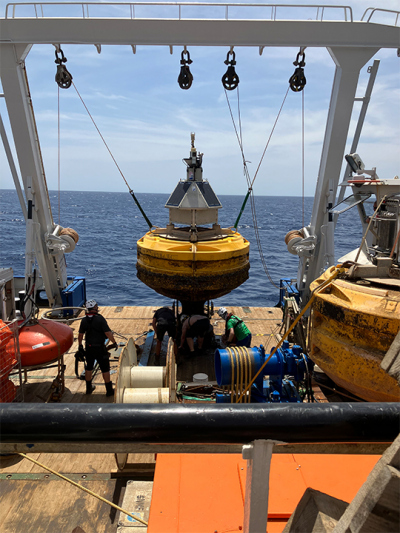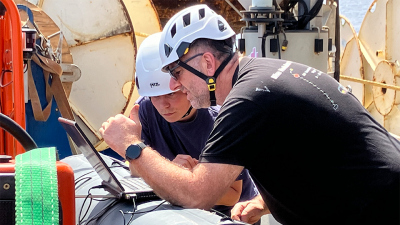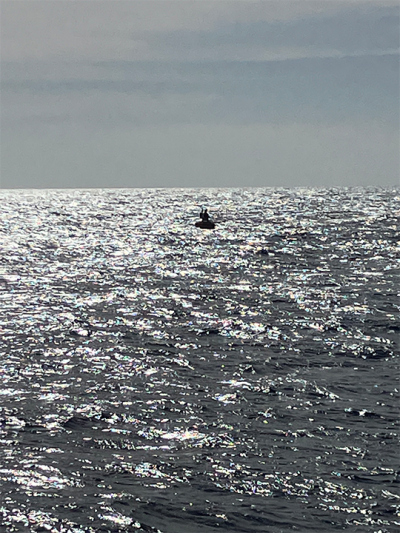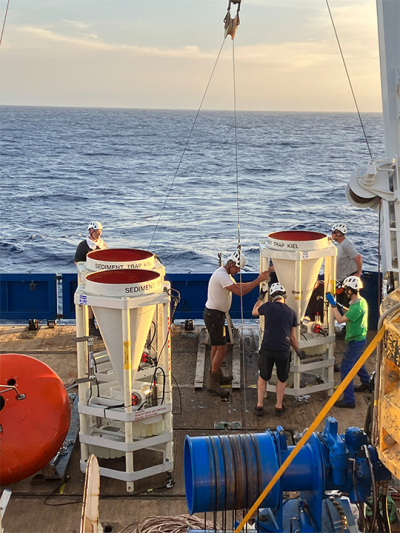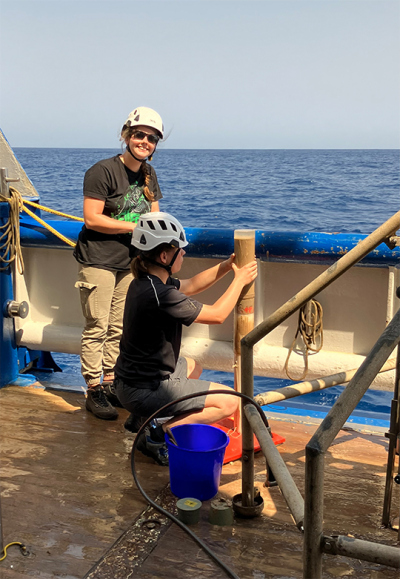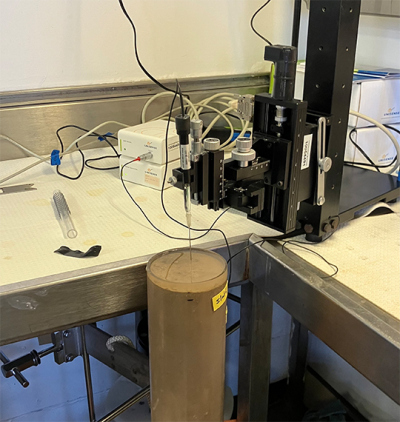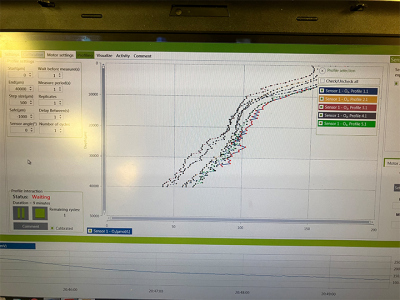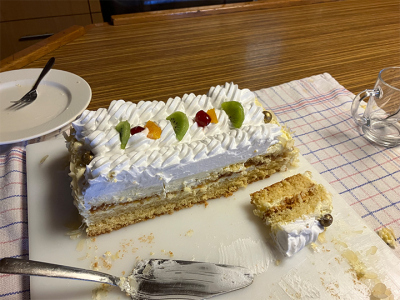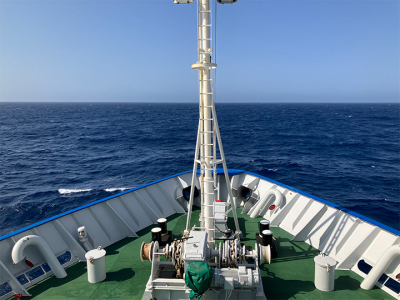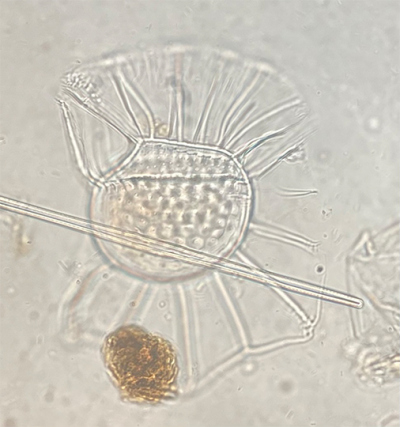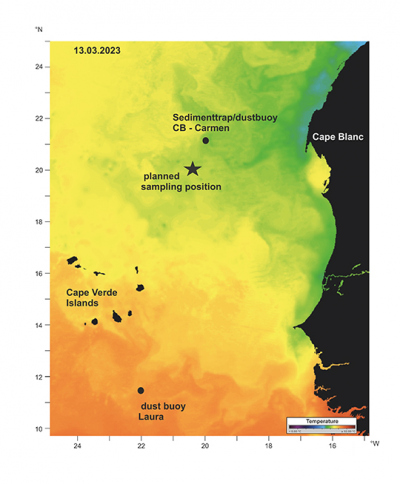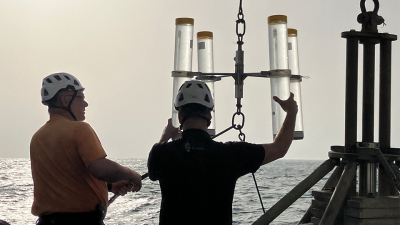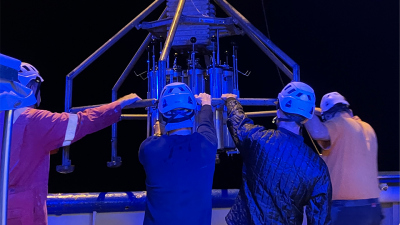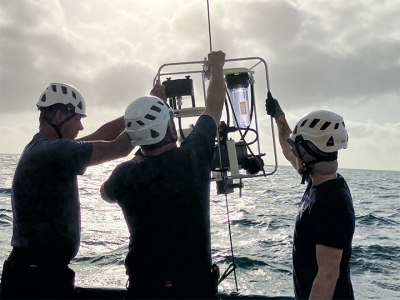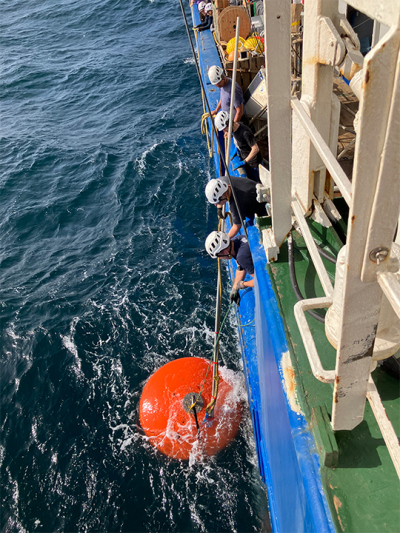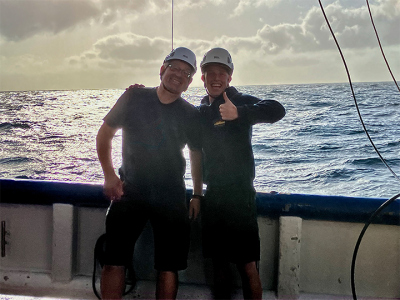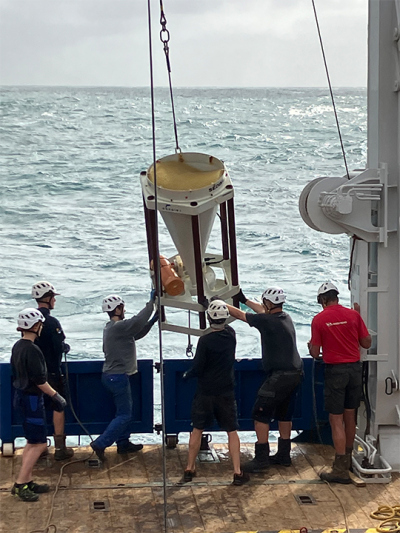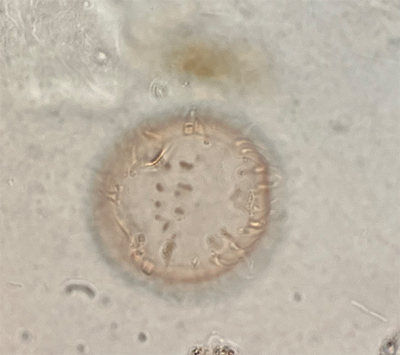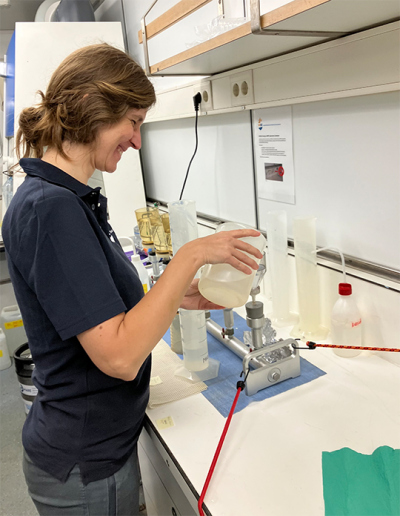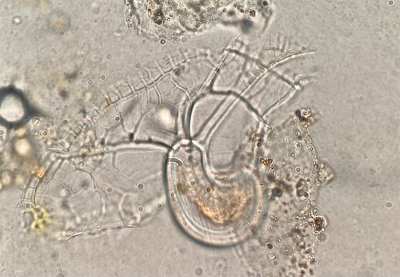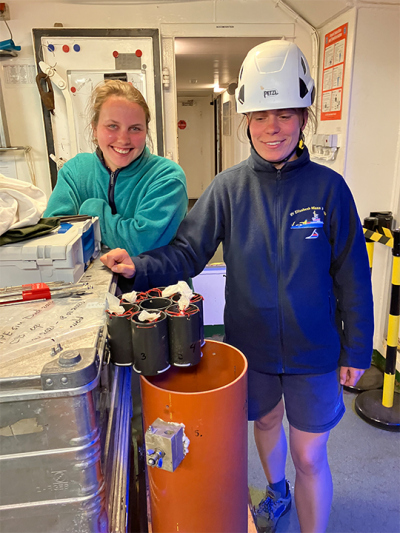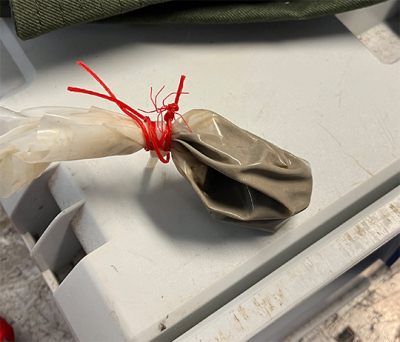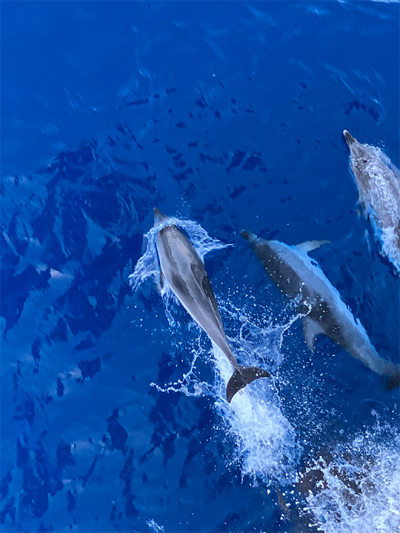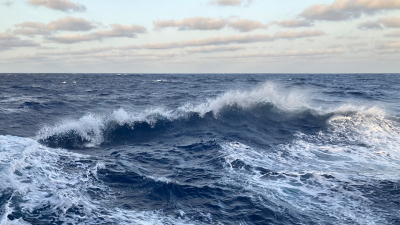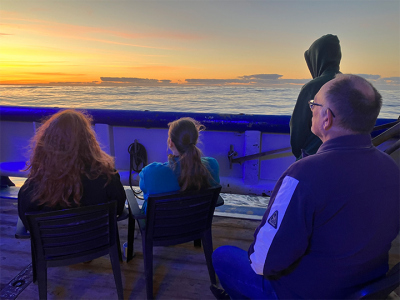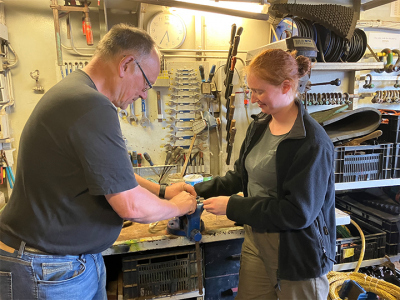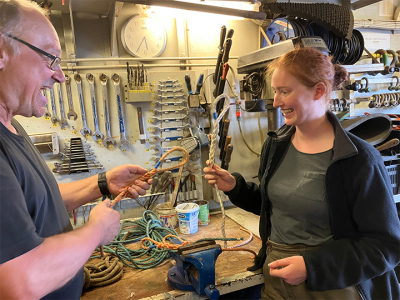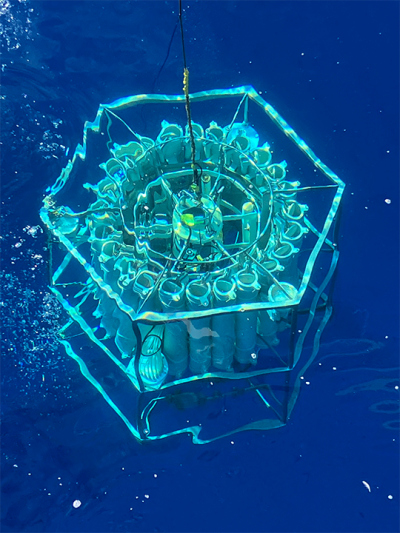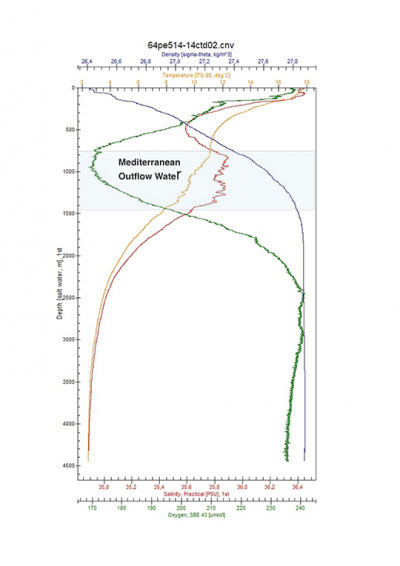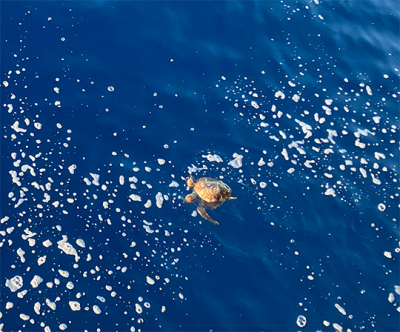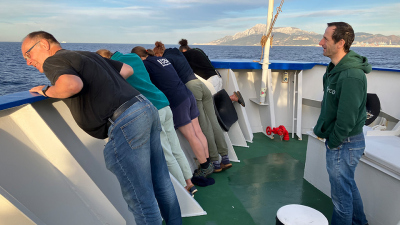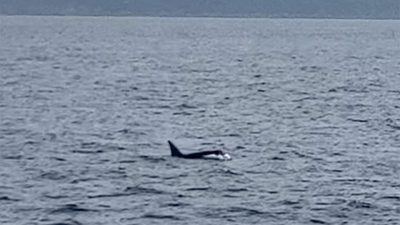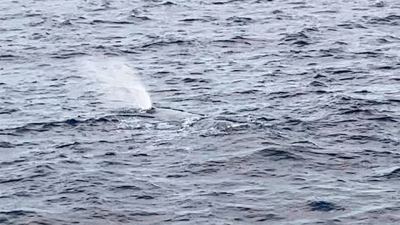- Home
- Discover
- Ship's logs
- Logbuch RV Pelagia Dust-2023
Logbuch RV Pelagia Dust-2023
Expedition with the R.V. Pelagia to Cap Blanc
The R.V. Pelagia is a Dutch research ship deployed by the Royal Dutch Institute of Sea Research (NIOZ). A Team from the German Science Foundation funded Excellence Cluster “The Ocean Floor – Earth’s Uncharted Interface” RECEIVER and RECORDER Units will join this cruise to the subtropical region southwest of the Cape Verde Islands and the upwelling area off Cape Blanc (NW Africa). The eastern subtropical Atlantic upwelling area off Cap Blanc (NW Africa) is one of the most productive regions in the world. This is due to the high input of nutrients in the upper water column that are upwelled from deeper waters and enter the region in the form of Saharan Dust Input.
The region plays a key role in the global carbon cycle and as such influences the global climate. Particles that have trapped atmospheric CO2, sink from the upper water column towards the ocean floor and as such form a sink for atmospheric CO2. These sinking particles are the focus of a long-term monitoring program of the MARUM. In this program the particle production in relationship to climate change are followed since 1988 by collecting the flux of particles sinking through the water column by moored sediment traps.
At the same position of one of the MARUM sediment trap moorings, the NIOZ deploys a so called "dust-buoy" that collects dust from the atmosphere. This allows us to directly correlate variability in particle export flux with the input of Saharan dust.
Throughout the years a close cooperation exists between the MARUM and the NIOZ and a Dutch team frequently joined MARUM expeditions to the region. This time, a MARUM team is welcome at the R.V. Pelagia to service the MARUM sediment trap moorings and perform investigations in the scope of current activities in the excellence clusters units RECEIVER and RECORDER.
Apart from servicing the sediment trap moorings they will study the particle production in the upper water column, the sinking behavior (transport) through the water column and preservation/degradation at the ocean floor. For this, the particle flux from the upper water column will be sampled with free drifting traps. These traps float with the upper water currents and collect the particle at different water depths. At the same time, temperature, salinity, chlorophyll-a content and turbidity of the water column will be recorded throughout the surveys. Apart from this the particle content of deeper water layers will be collected by so called "in-situ" pumps. Furthermore, ocean floor sediments will be collected to study the long-term changes in the region and investigate to what extent anthropogenic pollution has influenced the ecosystem.
The team of expedition R.V. Pelagia - Dust 2023 will report on the cruise and everyday life on board in an expedition log.
More information:
Current position of the research vessel R.V. Pelagia
Contact:
Prof. Dr. Karin Zonneveld
Micropaleontology – Paleoceanography
MARUM – Center for Marine Environmental Sciences, University of Bremen
Phone: +49 421 218 65797
Email: [Bitte aktivieren Sie Javascript]
Friday 03.03.2023; “We’re on our way”
Lisbon.
Today we started our trip a little bit different as initially planned (by car in stead of train/bus) because of the big demonstrations in Hamburg and Bremen today that severely hampered the use of local train/bus and metro connections.
We safely made it on time for our flight to Lisbon where we have to stay for one night to travel further to the Cape Verden where the ship Pelagia is expected to be waiting for us tomorrow.
Before the cruise we needed quite some preparations, not only by sending our research equipment by container to Mindelo already early February, but also in preparing ourselves by absolving a marine life-safety training. There we practiced in the swimming pool of the Dutch town Emmeloord how to behave in case of emergency for instance, how to put on a safety suit as fast as possible and climb in a floating life raft.
Saturday 04.03.2023; "Arrival in Spring"
Mindelo/Cape Verde.
Today we arrived safely in a nice warm sunny Mindelo (Cape Verde).
The Pelagia had some delay so that made it possible for us to see the ship entering the Port of Mindelo in the late afternoon. It gave us some time to get used to the transfer from cold-gray Germany to the subtropical spring on the Cape Verde. Tomorrow we will go to the ship to get ourself settled and start to unload the equipment from the container and set up our working places.
Monday 06.03.2023; “Parking Jam”
Mindelo/Cape Verde.
Under a beautiful blue sky with a refreshing breeze a busy day started. Today the containers with our equipment arrived and we have to prepare the laboratories for the upcoming cruise. Although this sounds easy, in practice this requires quite some logistic puzzling. This since the arriving containers with equipment of the upcoming “Dust-2023” cruise have to contain all the equipment of the previous cruise on their return way to Europe. So... first the containers have to be emptied with our equipment stored somewhere where it is out of the way, then the equipment of the previous cruise has to be stored in previously emptied container and care has to be taken that every container exactly contains that equipment what is written on its custom papers……. Happily, the MARUM Logistic team members Marco and Götz handle this reality version of the “Parking Jam” game excellently.
Tuesday 07.03.2023; “On our way”
Between Cape Verde Islands.
Finally in the early evening the Pelagia was ready to sail off. This meant, the fuel had been refilled, new food and water taken in and all the scientific equipment was stored and sealed safely in the laboratories and storage containers. We waved goodbye to the friendly and colorful city of Mindelo and sailed the sunset painted horizon in between the Cape Verde Isles south for our first research station where we hope to arrive at Thursday morning.
Wednesday 08.03.2023; “Testing”
Southern Cape Verde Islands 14.5423 N, 23.8863 W.
Fortunately, the nice weather has followed us from Mindelo and today not only the sky is blue but also the Ocean shows its best side.
Today is a day of testing. We started the day with a safety drill to get ourselves familiar with the fastest way out of the Ship to the assembly point and life rafts to be well prepared in case of emergency. Here we tested if the survival suits everybody got at the start of the cruise were of the right size.
After this we started to test all our scientific equipment to see if nothing got damaged during transport to Mindelo. We successively adapted our equipment to the ships specific characteristics such as the thickness of the wires which are used to deploy devices in the deep ocean.
Not all tests can be done on deck. For instance, the so called “CTD” a device that measures the temperature and conductivity of see water from the surface to just above the ocean floor (on our location 4038 m), only functions when it is in contact with Seawater.
As a result, we stopped near the most southern Cape Verde Islands to run a test CTD and tested if not only the CTD itself but also the additional sensors that measure the oxygen concentration as well as the amount of particles in the water column (turbidity), functioned.
Fortunately, so far all tests were positive providing the best prerequisite for successful deployment of the devices on our first station tomorrow.
Thursday 09.03.2023; “Laura” collecting dust
Southeast of the Cape Verde Islands. 11.3592 N, 22.9803 W.
Just after lunch we saw “Laura” as a yellow spot at the horizon of a bright blue ocean. “Laura” is the name of one of the two dust collecting buoys of the Royal Netherlands Institute of Sea research. For part of the MARUM team it was “a welcome back” as she was put to sea at the MARUM Receiver cruise MSM104 in November 2021.
Since then, she has been collecting Sahara Desert dust from the atmosphere. This dust contains a lot of nutrients that fertilizes the ocean stimulating phytoplankton growth. This plankton also takes up CO2 that has been diffused from the atmosphere into the ocean water. When the plankton dies, it sinks to the ocean floor carrying this CO2. As such, it is a natural process that removes CO2 out of the atmosphere to be stored at the ocean floor.
To date, it is however not exactly known how much CO2 is extracted from the atmosphere when dust is blown into the ocean. To enable the study of this process “Laura” did not only collected dust but was also equipped with many sensors that registered the ocean water temperature, salinity, amount of rainfall and wind speed.
After a safe recovery of Laura, the NIOZ research team of Prof. Jan-Berend Stuut immediately started to extract the data from the sensors and servicing the buoy as we plan to put her to sea again tomorrow for another two years of dust and data collecting.
Friday 10.03.2023; “Sediment traps”
Southeast of the Cape Verde Islands 11.3592 N, 22.9803 W,
In contrast to the water near the MARUM where winter gives “goodbye snow greetings”, our day started again with a blue ocean and subtropical temperatures. The morning of this Friday was filled with preparing “Laura” for another sampling interval. She got completely new devices that were prepared already at the NIOZ in the Netherlands. Just after Lunch she could be released to the ocean again.
After waving her goodbye we immediately sailed to the position of the nearby sediment trap mooring. Sediment traps are big funnels that collect particles that sink from the ocean surface down to the ocean floor. They are connected on a wire to an anchor at the ocean floor and are kept upright with floating bowls. The whole construction of anchor, wire, traps and drifting bowls are called a mooring.
Under the sediment trap funnel, little sample cups are connected that collect the material that falls down through the funnels. A computer system takes care that the cups are being replaced after a defined amount of days. At the position of “Laura” the traps were positioned at 1150 m and 1250 m water. During the last one and half years, the cups were replaced every 4 days.
Large part of the particles that are being collected are formed by remains of plankton that was formed in the upper ocean and has taken up CO2. By combining the information collected by the dust buoy “Laura” with the content of the buckets, information is received how dust input relates to the amount and composition of the sinking particles and the retrieval of CO2 from the atmosphere.
Saturday 11.03.2023; “Mud and Cake”
Our Saturday morning started with the collection of ocean floor sediments with a multicore. This device is connected with a wire to the ship and is placed on the ocean floor (at our position 5200 m deep). Due to weights on top of the device, cores are “pushed” into the sediments after which lids close the top and bottom of the cores.
On deck part of the collected cores are sliced in parts, part of the cores are stored at -20°C to be further sampled and studied in Bremen. There we will study the amount and (molecular) composition of the organic particles that have been settled on the ocean floor. Some organic particles are prone to degradation when oxygen is present and as such release again CO2 into the ocean water. To obtain insight into this process, we measure the oxygen concentration in the upper part of the collected sediment cores immediately after recovery.
After recovering of the cores there was coffee with a surprise. One of the Pelagia crew members celebrated his birthday and the Alex the chef has treated us to a super delicious self made cake.
Monday 13.03.2023; “Transit”
We are sailing North, on “transit” to the region north east of the Cape Verden Islands where we hope to arrive on Wednesday morning.
During the transit we stop every day at eight o’clock in the morning to measure the properties of the water column and collect water samples. These water samples will be investigated on their plankton content by Catharina. She filters the collected water directly after collection but stores the filters for further investigations at her home University in Lissabon (Portugal).
The transit time is used by the MARUM team to investigate the particles collected by the drifting trap in the vicinity of the dust buoy “Laura”. These small traps are connected on a wire that in turn is connected to floating devices. The drifting traps are released in the water to drift freely with the currents. The traps were placed such that they collected particles at 100m, 200m and 400m water depth. During the transit we investigate what particles the trap collected. For this the collected material has been concentrated and put on microscopic slides to allow their investigation by light microscopy.
Tuesday 14.03.2023; “Hunting upwelling filaments”
By heading north, we are slowly leaving the nice warm tropical waters and arrive the first signs of colder waters prevailing off the Cape Blanc. This causes that for the first time this cruise we need to wear pullovers instead of t-shirts when we work on deck.
These colder waters have their origin near the coast of Cape Blanc. The prevailing winds from the northeast push the surface waters of the ocean away from the coast into the open ocean. These “pushed away waters” are being replaced with waters coming from the deeper parts of the ocean. This process is called upwelling. The upwelled waters are, apart of being colder than the surrounding waters, rich in nutrients that fertilize the upper ocean increasing the plankton production and as such the CO2 storage in marine organic matter. The upwelled waters that are being “blown away” form large offshore drifting filaments of colder water. At the moment they can be observed at a distance of about 640 km from the coast (ca 340 nautical miles). Tomorrow we plan to investigate and sample waters of the distal part of one of these filament. This to obtain insight into the amount and composition of organic matter particles that sink to the ocean floor as well as their final fate in the deep ocean floor sediments.
For finding the location where to study these processes, we need information of the exact position of these highly dynamic filaments. We do this by studying satellite images of sea surface temperatures provided by the NASA “state of the ocean” project: https://soto.podaac.earthdatacloud.nasa.gov
Wednesday 15.03.2023; “sampling, sampling, sampling”
West off Cape Blanc 20.2407 N, 20.7812 W.
After a beautiful sunrise we arrived at the distal part of the Cape Blanc upwelling filament. Because of the Sahara dust in the air the rising sun was colored more orange as normal and the air looks as if a slight orange filter has been placed in front of our eyes.
We started the day with the release of the drifting trap that will drift with the filament waters to collect for 24 hours sinking particles from the upper waters. Then we sampled the particles in the deeper waters just above the sea floor at 3988 m and 3983 m depth with in-situ pumps.
These are a sort of underwater vacuum cleaners that pump waters through a filter, in our case about 800 liters. The sampling ended for us with the sampling of surface sediment samples with the multicore. All devices worked perfectly and after a very long day of sampling we feel extremely tired but very satisfied.
Thursday 16.03.2023; “Dolphins and “Carmen” on the loose”
Off Cape Blanc 21.22 N, 21.0348 W.
Today we arrived at the location of the second dust buoy “Carmen” … at least, where “Carmen” should have been. “Carmen” is equipped with a sensor that gives every two hours a signal about her exact position. This is received in the control room at the Royal Netherlands Institute of Sea Research. Earlier this year it was visible that the position of Carmen suddenly moved towards the more central Atlantic Ocean … for some reason the cable that connected her to the anchor had broken and she started to drift with the currents.
Fortunately, another research vessel could pick her up and bring her safely to Mindelo. There we collected her and she is now waiting on the back deck to be released into the ocean again.
However, before we can do that, we first have to recover the rest of the cable that is still in the water and connected to the anchor. This cable has a length of 4 km and since it was loose in the water for several months there is a large change that it has become knotted. We therefore need some luck during the recovery that the “knotting” has not been too severe.
Luck we might have as on the transit between the last station and the position of Carmen we were accompanied for almost half an hour by a group of about 40 dolphins. The Dolphins “played” in front wave of the ship and we were treated to a real dolphin show. In many “Sea -tales” dolphins are “luck bringers” to the ship they accompanied and its crew and we hope this might come true. At least it brought a big smile on all of our faces to see these beautiful animals in their element.
Dolphins in front of the ship. Video: K. Zonneveld
Friday 17.03.2023; “Catch me if you can”
Off Cape Blanc 21.22 N, 21.0348 W.
Indeed, the dolphins have brought us luck today. The day started at sunrise with a spectacular event of more than hundred dolphins hunting together next and in front of the ship. They jumped simultaneously in groups of about 20 to 30 dolphins at a row to catch their breakfast.
Fortunately, quite a lot of us were able to see this unique happening as we were about to recover the in-situ pumps that had pumped and sieved overnight 900 liters of sea water just above the ocean floor at 4188 m depth over a filter with mesh size of 20 μm. The particles on the filters are being studied by light microscopy. Based on their morphology we can identify which particles origin from the Sahara Desert and Savannah, which from the coastal upwelling cells and which from the open ocean. This gives us information what part of the organic particles that settle on the ocean floor are produced above the sampling site and what part is transported over long distances from the coast towards the deep sea.
After the successful recovery of the in-situ pumps it was time to “catch” the cable with which “Carmen” was once connected to the anchor at the sea floor. On this cable a so called “smarty” is connected. This smarty is a floating device that brings up the cable to the surface of the ocean after the connection of the cable with the anchor is released. When the smarty reaches the surface it has to be connected with a hook to a cable from the ship. After this, it can be hived on deck and the “Carmen anchor cable” that is still connected to the smarty can be recovered.
Due to the, relative to earlier days, stronger winds and higher waves, it was not easy to get holt on the smarty but after half an hour trying, our MARUM college Götz got it hooked.
Fortunately, luck was with us and the wire was not knotted which caused that the rest of the recovery could be executed without any problems.
Sunday 19.03.2023; “Bye bye sediment trap mooring CB33”
Off Cape Blanc 21.2173 N, 20.8997 W.
After a “bumpy” night with quite high waves that came from different directions our day started early. Yesterday in the morning the dust buoy “Carmen” was released and in the early evening, we were able to safely recover the MARUM sediment trap mooring “CB32”.
This mooring that has its anchor at 4178 m water depth, contained two sediment traps that had collected downward falling particles in their funnels since November 2021. Below the funnels, bottles are being connected that are placed on a carousel. A small computer regulates that after a defined number of days the carousel turns a new bottle under the funnel while at the same time closing the previous bottle.
The MARUM sediment trap series has collected particles on this position since the year 1988 and is therefore one of the longest series in the world.
We not only investigate the amount of particles that are being trapped in the funnels, we also look at their content. By doing that we could see that over the last 10 years the amount of particles formed by plankton that prefer waters with more nutrients increased synchronously to an increase in the intensity of dust storms on the nearby continent as well as the increasing atmospheric CO2 concentration.
Monday 20.03.2023; “What a wonderful (hidden) world in a water drop”
South of the Canary Islands 23.9295 N, 19.9683 W.
During the night we all were lulled to sleep by the now more gentle movement of the ship as the wind speed reduced and the sea became calm again. The morning welcomed us with a wonderful sunrise over a blue ocean.
The day started with a last CTD station south of the Canary Islands before we start our transit north to our port of destination Malaga (Spain) where we will arrive in a week from now.
The water collected from this CTD/Rosette looks on first sight just normal clear empty water. But if you look closely, for instance by sieving of filtering the water and looking at the residue with a light microscope, it is full of life in the most fantastic forms.
Our college Catarina filters the seawater to investigate what part of the phytoplankton association is formed by coccolithophorids. Immediately after recovery of the CTD/Rosette, she transfers the collected water samples to her lab-container where they are filtered over micropore filters with pore sizes of 1 μm. Coccolithophorids produce small calcareous platelets, which morphology is specie specific. As the delicate details of these platelets are too small to be seen by light microscopy she will analyze her samples by electron microscopy in her home office in Lisbon. There she hopes to obtain insight into to what extend these photosynthetic organisms react on the ocean fertilization by wind-blown Sahara dust particles.
We sieved some remaining water to have a look at the hidden world in a water drop of ocean water by using our light microscope with 400x to 1000x magnification. We were baffled by the beauty of the organisms living in sunlit parts of the world’s oceans, wondered by the complexity of the ecosystems they are living in and were stunned when we tried to calculate what gigantic amounts of individuals of these organisms the world ocean inhabit. Seeing these organisms made us realize once more how careful we have to be with our beautiful blue planet.
Tuesday 21.03.2023; “Heading North”
In between the Canary Islands 27°49.620’ N, 17°39.228’ W.
By sailing north to Europe, we will cross two times a time boundary and last night the clock on the ship was turned one hour in advance. This meant that we all had to wake up one hour earlier. The advantage of this is that now all of us were able to watch the sunrise over a blue ocean that was sprinkled with small white dots of the waves that had increased in height again due to the increasing wind speed.
Although our station work has ended that does not mean that we can relax. Apart of writing the cruise report we have to safely store our samples in such a way that we can collect them without problems in the Netherlands when the ship arrives there halfway April.
Some samples get extra attention as they are unique in the World. These are for instance our “degradation experiment” samples.
When organic material sinks though the water column and settles on the ocean floor, part of this material is degraded by bacteria/archaea and the stored (atmospheric) CO2 is released to the ocean again. This degradation is selective with some molecules being “eaten” by the microbial community more often and efficient as other molecules. So far it is not exactly known what the molecular characteristics of the easy degradable and resistant particles are.
This is however extremely difficult to study in laboratories as it is impossible to create an artificial environment with exactly the same water pressure and microbial community lives as in the ocean.
So… we decided to carry out an experiment in the ocean itself. We collected sediments from anoxic environments where no degradation had taken place jet, analyzed the particle composition and molecular characteristics, divided the material in small parts and put these sediments in nets with such a small pore size that bacteria and archaea can swim in and out but the organic matter particles remain inside. These bags were placed in a tube with holes such that ocean water can flow in and out. In turn this tube was connected to one of the sediment traps that is hanging in oxygen rich waters at ca 1300 m depth.
Every time we service the traps we collect part of the sample bags and analyze it on their particle composition and their molecular characteristics. So far we exposed the material in November 2018 and collected sample bags in August 2020 and November 2021. The bags we collected now where therefore exposed for five years to oxygen rich water.
This afternoon exactly at time of the coffee break we were visited for the second time this cruise by a large group of dolphins that played for a while in the front wave of the ship. How beautiful the ocean is.
Wednesday 22.03.2023; “The wide ocean”
North of the Canary Islands 30°37.278’ N, 16°30.228’ W.
We crossed a time boundary again, so we have to cope with an hour less sleep once more. We are now in the same time zone as Bremen and Malaga, our port of destination. Unfortunately, we have to reduce the duration of the night again during this trip as in Germany summertime will start this weekend. This stepwise reduction of three hours of sleep cause that we feel quite jet-lagged. Our feeling of a lack of sleep is enhanced by the rather strong movements of the ship sailing against the waves and trade winds.
Nevertheless, we used today to organize our collected research data, write the research report and place all data and preliminary results on the internal server of the ship so that all of us have the required background date for our further analyses at home.
The time changes caused however that we now were able to enjoy after dinner the beauty of the wide ocean in the evening light.
Movement of the ship. Movie: K. Zonneveld
Thursday 23.03.2023; “Splicing”
Somewhere on the Atlantic 33°28.152’ N, 13°54.360’ W.
This morning started with a fantastic sunrise over a blue ocean. The wind has disappeared and as the waters we are sailing in are colder than before, the tropical moistness has disappeared and we could enjoy a beautiful nice warm day.
As the waves are gently but very long and high so that the ship has got a gentle but still strong movement. Our coffee cups have their “own life” when we put them on a table without “anti-slip” covering.
This afternoon the sediment trap team Götz, Marco and Ramona dived into the workshop of the ship to maintain and repair some parts of the traps. There they learned from the Dutch crew how to splice wires and cables. This is an old technique that is still used on ships since good spliced cables cannot be constructed by machines. This technique is needed to make stable loops in cables and wires that do not break or loose when force is applied on the cable.
The crew of the Pelagia gave Götz and Ramona cords to practice on, explained the technique and gave advise when mistakes were made. At the end of the day they had not only learned a handcraft that is already been used and further developed for centuries on ships, their skills in the Dutch language had increased spontaneously as well :-)
Friday 24.03.2023; “Very very last CTD and turtles”
Somewhere on the Atlantic 34°38.921’ N, 12°30.053’ W.
Again, a beautiful day with a blue sky, no wind and an almost "silky" ocean surface on which we are gently moving on the large ocean waves.
Due to the nice weather, the ship can sail more rapidly as the days before where it had to fight against the wind and waves. This made it possible to enlarge the south-north "plankton transect" with another CTD station. On this position the CTD profile showed a clear signal of outflowing Mediterranean water at intermediate depth. This water is relatively warm but very saline as during it's time in the Mediterranean much water has been evaporated.
The density is such that it is more heavy as the surface water but less heavy than the Atlantic deeper waters. The results is that when it leaves the Mediterranean over at the Strait of Gibraltar, it dips down under the Atlantic surface Waters but "floats on the Atlantic Intermediate and Deep Waters. In the CTD profile it is recognizable as an intermediate water mass with higher salinity concentrations.
In the evening, we crossed an area where many sea turtles were living. They were sticking their heads out of the water to have a look at the Pelagia. Again, another fantastic experience where we were allowed to enjoy the beauty of the Ocean and the life within.
Saturday 25.03.2023; “Pelagia on the wide Atlantic Ocean”
Today we closed all the research activities and packed our equipment in the boxes and Container to prepare ourselves to enter the Port of Malaga early Monday morning. Tomorrow we will pass the Strait of Gibraltar. We notice that we are sailing in the direction of the more "inhabited" world as more ships pass by as that we have seen the days before where we had the feeling we were completely alone on the wide blue ocean.
Sunday 26.03.2023, “Street of Gibraltar”
Steet of Gibraltar 34°38.921'N. 12°30.053'W.
Again we were very lucky with the weather and a after a "very early" breakfast (also for us summertime started) slowly a horizon became visible in the still very dark ocean environment , to announce the start of another fantastic sunrise.
By approaching the street of Gibraltar more and more other ships appeared next, before and after us. In the late morning, we saw the mountains of Marokko appearing at the horizon and soon also the Spanish side was visible.
By entering the Street of Gibraltar, we were extremely, extremely lucky.
First a group of Orcas decided to hunt next to the ship. Not much later after dinner when we all were together at the front of the ship to enjoy the evening sun on the spectacular rocks of Gibraltar and the northern part of Africa, a group of large dolphins joint us for a while. In the group of dolphins there was a mother with child that swam synchronously with its mama. Their jumps out of the water in the low standing evening sun was spectacular and all of us (both scientific and ship crew) were enjoying the scene on the front part of the ship...... and if this was not enough....., shortly afterwards a plume of water was spotted in front of the ship: a sperm wahle who decided to swim to the side of the ship so that everybody could see him/her dive into the deep again.
This was the most spectacular goodbye the Atlantic Ocean could give to us. A perfect end of our last day at sea.
Tuesday, 28.03.2023; “Goodbye and many thanks to the Pelagia and it’s fantastic crew”
Malaga.
We arrived in Port yesterday and it is now time to say goodbye to the ship that has been our home for the past three weeks. We have packed our equipment safely for transport to Texel (The Netherlands) where we will pick it up when the ship arrives there next month, cleaned our cabins and gone through the ship to thank chief scientist Jan-Berend Stuut and all crew members for their fantastic support, the good food and the nice atmosphere that made life and working on board a success.
Thanks also to you readers for following us,
many greetings from a sunny Malaga.
